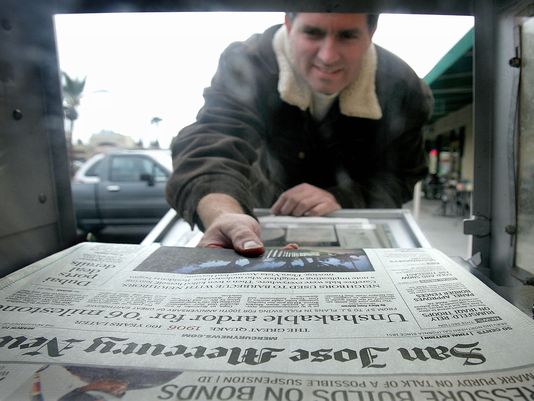
Digital First Media, the New York owner and operator of the nation’s second-largest newspaper chain, announced Friday that it will “evaluate and consider strategic alternatives” that could lead to a quick sale of some or all of the hedge fund-sponsored company.
Digital First’s is comprised of 800 multi-platform news and information products, including 76 daily and Sunday newspapers and 160 weeklies serving 75 million customers monthly. The llargest of its properties include the San Jose Mercury News, the Los Angeles Daily News, the Denver Post, The New Haven Register, the St. Paul Pioneer Press, and the Salt Lake Tribune.
Digital First was formed only nine months ago with the merger of MediaNews Group and the former Journal Register Company led by hedge fund Alden Global Capital. At the time, national newspaper circulation revenue actually grew in 2013 by 3.7% to $10.9 billion last year, but newspaper print advertising revenue fell by 8.6% to $17.3 billion, according to The Newspaper Association of America.
Digital First management probably thought they could leverage their presence onto Internet and mobile devices for news, but newspaper digital advertising revenue has only increased 1.5% to $3.42 billion. But that wasn’t enough to offset the industry’s 8.6% drop in print advertising revenue to $17.3 billion.
CEO John Paton said the company has retained UBS Securities to review a full range of alternatives — including selling the entire company, selling regional clusters, or doing nothing. Most analysts interpret these words to mean that the company is seeking a quick transaction at possibly fire-sale prices.
“We believe we have many options available to us to maximize the value of our businesses for our stockholders, and the board of directors has therefore decided to assess the full range of these opportunities,” Paton said.
In a prepared statement to employees, the company said there are no assurances that the process will result in a transaction or transactions or on the timing of any decisions. The company also said that it will not disclose developments in the process until the Board decides how it will proceed.
Digital First has been approached by various interested parties over the past months, said Paton, but there have been no “formal or serious” discussions. While the company could be sold in whole, or in regional chunks or expanded or not sold at all, “one of the benefits of making these announcements is you end up testing the marketplace for all of those options, rather than doing it theoretically,” he said.
Paton stated that the combined company’s digital ad revenue is approaching about $200 million per year. “The strategy we pursued was to put the companies together and to drive digital revenue relentlessly.” At the same time, the spin-offs of print publishing by a number of media companies have received a good reception from investors, he said. “Over the past year what you have seen is a remarkable resurgence in the market, with the realization of the real power of media companies to go forward.”
All of this sounds like happy talk to me. After just five months, Digital First shut down its experimental, centralized digital newsroom, called Project Thunderdome, which was supposed to transition the company to becoming predominantly digital. Paton said Friday’s action is unrelated to Thunderdome, which he tried to underplay as just one of many digital experiments the company has undertaken.
It will be extremely difficult to find a buyer for Digital First Media as a whole, and with so many different website names, it is unclear that Digital First can operate as a stand-alone news site like Breitbart or Huffington Post. The company’s best hope seems to be trying to find regional buyers.
“They could decide to break up the business into different operating entities — a Rocky Mountain cluster, an East Coast cluster, and a California cluster,” said Alan Mutter, a media consultant and former newspaper executive based in Silicon Valley who regularly blogs on print and digital media.
“The news information industry in America is undergoing a period of seismic change, defined by the need to consolidate to rapidly compete in a digital world,” Paton said. “The companies that will succeed are those which have meaningful scale and digital expertise. By anticipating the rapid revolution in our industry and responding to stay ahead of the curve, DFM has clearly emerged as a leading player, based on the high quality of our assets and the extensive work we have done to transform them into multi-platform products.”
At Digital First Media’s news conference, there was no band playing a last song like the 19th Century Christian hymn “Nearer, My God, to Thee” that is alleged as the last song the band on RMS Titanic played before the ship sank. But the print newspaper industry seems doomed to continue sinking.
Chriss Street suggests that if you are interested in California businesses please click on NEVADA GOVERNOR SIGNS $1,538,000-PER-JOB INCENTIVE FOR TESLA GIGAFACTORY

COMMENTS
Please let us know if you're having issues with commenting.